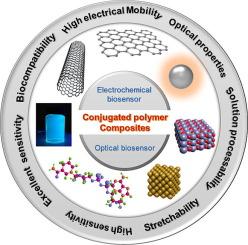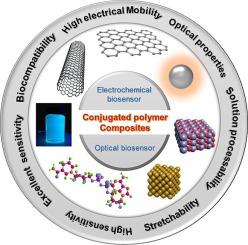基于共轭聚合物复合材料的病毒生物标志物检测生物传感器的挑战与发展策略
IF 13.2
1区 工程技术
Q1 ENGINEERING, CHEMICAL
引用次数: 0
摘要
随着先进材料和技术的发展,人们提出了许多策略来扩展导电聚合物(CPs)在病毒检测生物传感器中的适用性。导电聚合物复合材料(cpc)近年来因其创新的生物传感器平台而受到科学界的极大关注,这是由于单个组分的协同作用,产生了几个优越的优势,包括多功能特性、高机械性能、水溶性、优异的电荷传输特性和良好的溶液可加工性。各种材料已与CPs结合,合成了用于电化学和光学生物传感器的CPs,从而能够监测各种病毒生物标志物。然而,这些高可靠性和实用性的生物传感器的设计和制造仍然是一个很大的挑战。因此,提高这种生物传感器检测病毒生物标志物的可行性的开发策略是必要的。为了提供可靠的科学依据,本文对近年来基于cpcs的电化学和光学生物传感器的设计和制造的发展趋势、潜力和新兴方法进行了总结和讨论,从而鼓励进一步的研究。澄清了纯氯化石蜡使用中的问题和挑战以及氯化石蜡在该领域的潜在适用性。重点介绍了基于cpcs的生物传感器的基本组成和工作机制,以及不同材料的最新进展。基于cpcs的生物传感器作为设计高效、用户友好的生物传感设备的理想平台,具有很大的潜力,旨在快速、准确地诊断病毒生物标志物。本文章由计算机程序翻译,如有差异,请以英文原文为准。


Challenges and development strategies of conjugated polymers composites-based biosensors for detection of virus biomarkers
With the development of advanced materials and technologies, many strategies have been proposed to extend the applicability of conducting polymers (CPs) in biosensors for virus detection. Conducting polymer composites (CPCs) have recently garnered great attention from the scientific community for their innovation of biosensor platforms due to the synergy of the individual components which induce several superior advantages, including multifunctionalized properties, high mechanical performance, aqueous solubility, excellent charge transport characteristics, and good solution processability. Various materials have been combined with CPs to synthesize CPCs for use in electrochemical and optical biosensors, enabling the monitoring of diverse virus biomarkers. Nonetheless, the design and fabrication of these biosensors with high reliability and practical applicability have remained big challenges. Therefore, development strategies to improve the viability of such biosensors in detecting virus biomarkers are necessary. To provide consolidated scientific evidence, this review aims to summarize and discuss recent research on the development trends, potentials, and emerging approaches in the design and fabrication of CPCs-based electrochemical and optical biosensors, thereby encouraging further future studies. Problems and challenges in the use of pure CPs as well as the potential applicability of CPCs within this field are also clarified. The fundamental components and working mechanisms, along with the recent advancements of different materials for fabricating CPCs-based biosensors are highlighted as well. CPCs-based biosensors show great potential as an ideal platform for designing effective and user-friendly biosensing devices, aimed at the rapid and accurate diagnosis of virus biomarkers.
求助全文
通过发布文献求助,成功后即可免费获取论文全文。
去求助
来源期刊

Chemical Engineering Journal
工程技术-工程:化工
CiteScore
21.70
自引率
9.30%
发文量
6781
审稿时长
2.4 months
期刊介绍:
The Chemical Engineering Journal is an international research journal that invites contributions of original and novel fundamental research. It aims to provide an international platform for presenting original fundamental research, interpretative reviews, and discussions on new developments in chemical engineering. The journal welcomes papers that describe novel theory and its practical application, as well as those that demonstrate the transfer of techniques from other disciplines. It also welcomes reports on carefully conducted experimental work that is soundly interpreted. The main focus of the journal is on original and rigorous research results that have broad significance. The Catalysis section within the Chemical Engineering Journal focuses specifically on Experimental and Theoretical studies in the fields of heterogeneous catalysis, molecular catalysis, and biocatalysis. These studies have industrial impact on various sectors such as chemicals, energy, materials, foods, healthcare, and environmental protection.
 求助内容:
求助内容: 应助结果提醒方式:
应助结果提醒方式:


